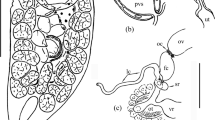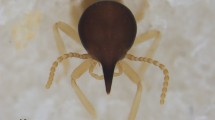Abstract
The present work was aimed to investigate the phylogenetic analysis of different species of Indian termites belonging to the family termitidae based on mitochondrial genes COI and COII. The sequences so obtained from public database revealed grouping of termites according to their ecological distribution. The sequences of the species under investigation were characterized on the basis of frequencies of nucleotide bases and in most of the species, a significantly high percentage of A+T base composition was observed. Phylogenetic tree revealed positioning of species according to the analysis of their cytochrome oxidase subunits.


Similar content being viewed by others
References
Roonwal ML (1955) External genitalia of termites (Isoptera). J Zool Soc India 7:107–114
Roonwal ML (1970) Isoptera. In: Tuxen SL (ed) Taxonomist’s glossary of genitalia in insects, 2nd edn. Munksgaard, Copenhagen, pp 41–46
Waller DA, La Fage JP (1987) Nutritional ecology of termites. In: Slansky F Jr, Rodriguez JG (eds) The nutritional ecology of insects, mites, and spiders. Wiley, New York, pp 487–532
Yeap BK, Othman AS, Lee CY (2009) Molecular systematic of Coptotermes (Isoptera: Rhinotermitidae) from East Asia and Australia. Ann Entomol Soc Am 102(6):1077–1079
Kirton LG (2005) The importance of accurate termite taxonomy in the broader perspective of termite management. In: Lee CY, Robinson WH (eds) Proceedings of the 5th Annual International Conference on Urban Pests, Singapore, p 1–7
Roonwal ML, Chhotani OB (1986) Wing microsculpturing in termite genera Odontotermes, Hypotermes and Microtermes (Termitidae: Macrotermitinae) and its taxonomic value. Zool Anz 178:236–262
Roonwal ML, Chhotani OB (1989) The fauna of India and adjacent countries: isoptera (Termites). ZSI, Calcutta
Vargol EL, Husseneder C (2009) Biology of subterranean termites: insights from molecular studies of Reticulitermes and Coptotermes. Ann Rev Entomol 54:379–403
Brown WM, George M Jr, Wilson AC (1979) Rapid evolution of animal mitochondrial DNA. Proc Natl Acad Sci USA 76:1967–1971
Moore WS (1995) Inferring phylogenies from mtDNA variation: mitochondrial gene trees versus nuclear-gene trees. Evolution 49:718–726
Mindell DP, Sorenson MD, Huddleston CJ, Miranda HC Jr, Knight A et al (1997) Phylogenetic relationships among and within select avian ordersbased on mitochondrial DNA. In: Mindell DP (ed) Avian molecular evolution and systematics. Academic, New York, pp 214–247
Miura T, Roisin Y, Matsumoto T (2000) Molecular phylogeny and biogeography of the nasute termite genus Nasutitermes (Isoptera: Termitidae) in the Pacific Tropics. Mol Phylogenet Evol 17(1):1–10
Piganeau G, Gardner M, Walker AE (2004) A broad survey of recombination in animal mitochondria. Mol Biol Evol 21:2319–2325
Hebert PDN, Ratnasingham S, deWaard JR (2003) Barcoding animal life: cytochrome c oxidase subunit 1 divergences among closely related species. Proc R Soc London 270:96–99
Hebert PDN, Cywinska A, Ball L, deWaard JR (2003) Biological identifications through DNA barcodes. Proc R Soc London 270:313–321
Chhotani OB (1997) Fauna of India-Isoptera (Termites), vol II. Zoological Survey of India, Calcutta, p 800
Sambrook J, Fritsh EF, Maniatis T (1989) Molecular cloning: a laboratory manual. Cold Spring Harbour Laboratory Press, New York
Bernasconi MV, Pawlowski J, Valsangiacomo C, Piffaretti J-C, Ward PI (2000) Phylogeny of the Scathophagidae (Diptera, Calyptratae) based on mitochondrial DNA sequences. Mol Phylogenet Evol 16:308–315
Simon C, Frati F, Beckenbach A, Crespi B, Liu H, Flook P (1994) Evolution, weighting and phylogenetic utility of mitochondrial gene sequences and a compilation of conserved polymerase chain reaction primers. Ann Entomol Soc Am 87:651–701
Williams JG, Kubelik AR, Livak KJ, Rafalski JA, Tingey SV (1990) DNA polymorphisms amplified by arbitary primers are useful as genetic markers. Nucl Acids Res 18(22):6531–6535
Altschul SF, Madden TL, Schaffer AA, Zhang J, Zhang Z, Miller W, Lipman DJ (1997) Gapped BLAST and PSI-BLAST: a new generation of protein database search programs. Nuc Acids Res 25:3389–3402
Thompson GJ, Higgins DG, Gibson TJ (1994) CLUSTALW, improving the sensitivity of progressive multiples sequence alignments through sequence weighting, position-specific gap penalties and weight matrix choice. Nucl Acids Res 22:673–680
Tamura K, Peterson D, Peterson N, Stecher G, Nei M, Kumar S (2011) MEGA5: molecular evolutionary genetics analysis using maximum likelihood, evolutionary distance, and maximum parsimony methods. Mol Biol Evol 28(10):2731–2739
Sobti RC, Kumari M, Sharma VL, Sodhi M, Mukesh M, Shouche Y (2009) Sequence analysis of a few species of termites (Order: Isoptera) on the basis of partial characterization of COII gene. Mol Cell Biochem 331:145–151
Aanen DK, Eggleton P, Rouland-levefre C, Guldberg-Froslev T, Rosendahl S, Boomsma JJ (2002) The evolution of fungus growing termite and their mutualistic fungal symbionts. Proc Natl Acad Sci 99(23):14887–14892
Jenkins TM, Dean RE, Verkerk R, Forschler BT (2001) Phylogenetic analysis of two mitochondrial genes and nuclear intron region illuminate European subterranean termite (Isopteran: Rhinotermitidae) gene flow, taxonomy and introduction dynamics. Mol Phylogenet Evol 20:286–293
Abe T, Bignell DE, Higashi M (2000) Termites: evolution, sociality, symbioses, ecology. Kluwer Academic Publishers, Dordrecht
Abensperg TM, Dion S (1997) Latitudinal gradients in the species richness of Australian termites (Isoptera). Aust J Ecol 22(4):471–476
Li HF, Ye W, Su NY, Kanzaki N (2009) Phylogeography of Coptotermes gestroi and Coptotermes formosanus (Isoptera: Rhinotermitidae) in Taiwan. Ann Entomol Soc Am 102(4):684–693
Lo N, Eldridge RH, Lenz M (2006) Phylogeny of Australian Coptotermes (Isoptera: Rhinotermitidae) species inferred from mitochondrial COII sequences. Bull Entomol Res 96(4):433–437
Cheng S, Kirton LG, Panandam JM, Siraj SS, Kit-Siong Ng K, Tan SG (2011) Evidence for a higher number of species of Odontotermes (Isoptera) than currently known from Peninsular Malaysia from mitochondrial DNA phylogenies. PLoS ONE 6(6):1–8
Acknowledgments
We acknowledge University Grants Commission (UGC), New Delhi for financial support; Department of Zoology and Department of Biotechnology, Panjab University, Chandigarh for required laboratory facilities.
Author information
Authors and Affiliations
Corresponding author
Rights and permissions
About this article
Cite this article
Sharma, V.L., Singla, M. & Sobti, R.C. Phylogenetic position of Indian termites (Isoptera: Termitidae) with their respective genera inferred from DNA sequence analysis of the mitochondrial cytochrome oxidase gene subunit I compared to subunit II. Mol Cell Biochem 384, 39–45 (2013). https://doi.org/10.1007/s11010-013-1779-3
Received:
Accepted:
Published:
Issue Date:
DOI: https://doi.org/10.1007/s11010-013-1779-3




